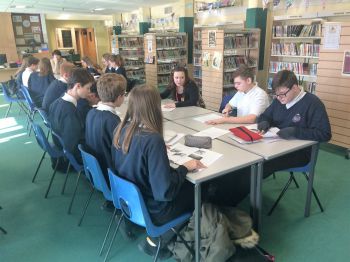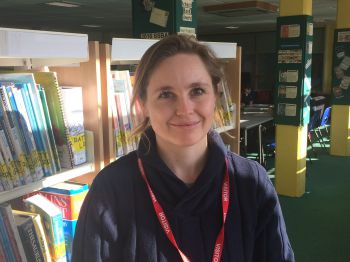Writing the wrongs
By: Jacqui Bealing
Last updated: Monday, 30 April 2018

Get writing: Students at Ratton School

Dr Emma Newport
What does “love” taste like?
“Like passionfruit.”
What does “love” sound like?
“A pigeon?”
In Ratton School’s library in Eastbourne, Year 10 pupils are responding enthusiastically to questions from Hanna Miles about metaphors and similes.
At another table, Gabby Grilla is listening to a group rip into the opening lines of Dan Brown’s thriller, The Da Vinci Code. “It says the attacker is fifteen feet away, so how can he see the colour of his eyes?”
Meanwhile, Rachael Keenan is helping a group shape their ideas for a short story about waiting in line.
“It depends on what you’re waiting for, and who’s there with you.”
“It could be for the afterlife.”
“Or a Chinese takeaway.”
Hanna, Gabby and Rachael are University of Sussex students who are part of Sussex Writes, an initiative started by the University to help support the creative writing needs of secondary school pupils.
Working with ten schools across East Sussex and Brighton, a team of around 30 students organise workshops twice a year for pupils in Years 9-11.
Dr Emma Newport, a lecturer in English and the coordinator of Sussex Writes, says: “We make students come alive to the fact that storytelling is in everything. It’s how we understand ourselves and the world around us.”
The schools select between 20 and 40 children for each workshop, although attendance is voluntary. Sometimes they are pupils who are struggling with dyslexia, or because English isn’t their first language. In other schools the groups include those who have shown a keen interest in creative writing and want more space to explore this.
“It’s whatever the school wants,” says Emma. “The objective is to supplement the schools’ English curriculum and support them with the creative element of the GCSE English exam.
“But what really seems to help is having the workshops run by young people who are close in age to the schoolchildren and can help them to push their creative writing in ways that are different from school.”
The initiative, which is supported financially by the University’s Widening Participation team and the Sussex Learning Network Collaborative Outreach Programme, began last year with Beacon Academy in north Sussex.
Emma says: “I was in conversation with Beacon Academy’s head of English, Dr Mark Fairbanks, about the creative element of the exam, and the fact that the University has such a rich source of creative writing talent among its students as well as members of staff, who are published writers.
“We wanted to see how we could bring these elements together in a way that would be beneficial to both the schoolchildren and the students.”
The University students, most of whom are in the School of English (although some are from other disciplines, such as psychology and history), are given guidance about how to run the workshops, but they largely create the content, including selecting some of the texts to criticise.
“The schoolchildren get a lot of pleasure out of picking apart Dan Brown’s writing,” says Emma. “It gives them a sense of their own authority that they can see what makes bad writing.”
For the discussions and exercises the schoolchildren are encouraged to explore voices different to their own, and to experiment with narrative structures.
“It’s all about disrupting what students typically produce,” says Emma. “That’s what will get them higher marks in an exam.
“We also want to help them to see that storytelling is important. They are surrounded by it. Court cases, journalism, adverts, computer games – they all rely on having a narrative.”
Some of the greatest successes have been with children for whom school and learning have been a turn-off.
Emma says: “When they say school is boring, we say, what is the colour of boring? They might say ‘beige’ or ‘brown’. And then we get them to describe a boring classroom and suddenly they are giving this interesting, rich description, which will get them lots of marks in the GCSE.
“What I hope we’re doing with these workshops is giving the students back some confidence. We’re not here to mark their spelling or their grammar, but to give them permission to be creative.”
The schools now benefiting from the workshops include Dorothy Stringer School in Brighton, Longhill High School in Rottingdean, Beacon Academy in Crowborough and Gildredge Park and Ratton School in Eastbourne.
Jade Kearney, an English teacher at Ratton School, has seen how the workshops are making a difference. “Some children might have missed out on attention or intervention and these workshops really spark their interest.”
For those running the workshops, the benefits in terms of their career and personal growth are also evident.
“Sussex Writes allows me to gain more teaching experience while spreading my insights and knowledge on creative writing, which is important to me,” says Gabby Grilla, a history student currently at Sussex on an exchange programme.
Rachael Keenan, now in her final year of an English degree, says: “When I first joined Sussex Writes, I was hoping to gain some valuable experience that might lead me into a career in teaching.
“I ended up gaining much more. I am constantly learning creative techniques from the people I work with and re-evaluating my own writing principles.”
The participants at Ratton School are in no hurry to leave when their workshop ends. Friends Dondy Sukoco, 14, and Callum Holton 15, carry on discussing the benefits of the sessions.
“I like the idea of writing,” says Dondy, “but I wouldn’t have known about these different methods and techniques. I wouldn’t have gone through these processes on my own.”
Callum adds: “I like having this opportunity to write and think about words.”
Additional funding managed through the Sussex Learning Network is enabling the programme to run this term and into the next academic year. This funding is part of the National Collaborative Outreach Programme developed by HEFCE (Higher Education Council for England) to encourage more young people into higher level learning.

